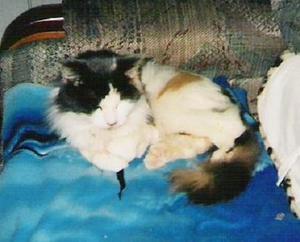In late November, 2005, my calico cat, Sophie, was about to come down with a serious feline respiratory illness, but I had no idea. My concern was directed to a lump in her groin and not to her slight sniffle.
I made an appointment with my veterinarian to get the lump checked out. A biopsy was scheduled. When I picked her up after her surgery, I noticed she was emitting a bad odor and was breathing funny, but I did not worry too much until the next morning.
Overnight her condition had worsened horribly. I could hear her rattling breaths from across the room. Alarmed, I phoned the vet and asked to bring her back in.
Within 24 hours Sophie had gone from a relatively healthy cat (aside from the lump–which turned out to be benign) to a critically ill cat. She was given an injection of antibiotics and put on oral antibiotics as well. The vet suggested I purchase a room vaporizer to help Sophie breathe.
That night was a long one. Sophie refused food, she had a fever, she was horribly lethargic, and her lungs made a terrible sound every time she took a breath. It sounded like she was drowning in her own fluids. Also, her nose was clogged with green mucus which I tried to continually remove with tissue.
Feline respiratory illnesses are not always so severe, but they can turn this bad very quickly. The bad odor was from the infection that had taken over her little body. The vet guessed that Sophie had probably been fighting this illness off, but that the stress of going to the clinic had lowered her immune system enough for the infection to take a serious hold on her. The lump on her groin turned out to be a swollen lymph node–probably a symptom of her infection as well.
Many lung infections begin as a URI, or upper respiratory infection. Most upper respiratory infections in cats are caused by a virus and are easily transmitted to other cats living in the same home. The feline herpes virus and the Calicivirus are the two main causes of URI’s in cats.
Most cat colds last about a week if there are no complications (but the cat will be contagious for much longer). It is common, however, for a secondary bacterial infection to occur–which is what happened to Sophie. Pneumonia can even develop (I suspect this is what Sophie had).
Because Sophie would not eat, I fed her small amounts via oral syringe. This has to be done with care so that the cat does not accidentally inhale any of the food. At the suggestion of a knowledgeable friend, I added feline Ester C to the food mixture in order to give Sophie an extra edge in fighting off the infection.
Between the antibiotics, the vaporizer, the Ester C, and a lot of attention, Sophie eventually recovered. There were several days when I was not sure she would make it through. Feline respiratory illnesses can be very serious. I urge cat owners to keep a close eye on any cat who has cold and watch for signs of a secondary bacterial infection.
Any cat with a upper respiratory infection, or signs of any other feline respiratory illness, should be checked out by a veterinarian. Anti-viral supplements can sometimes be given if a cat has feline herpes or a related virus. Antibiotics are necessary if a bacterial infection is also present.
.




